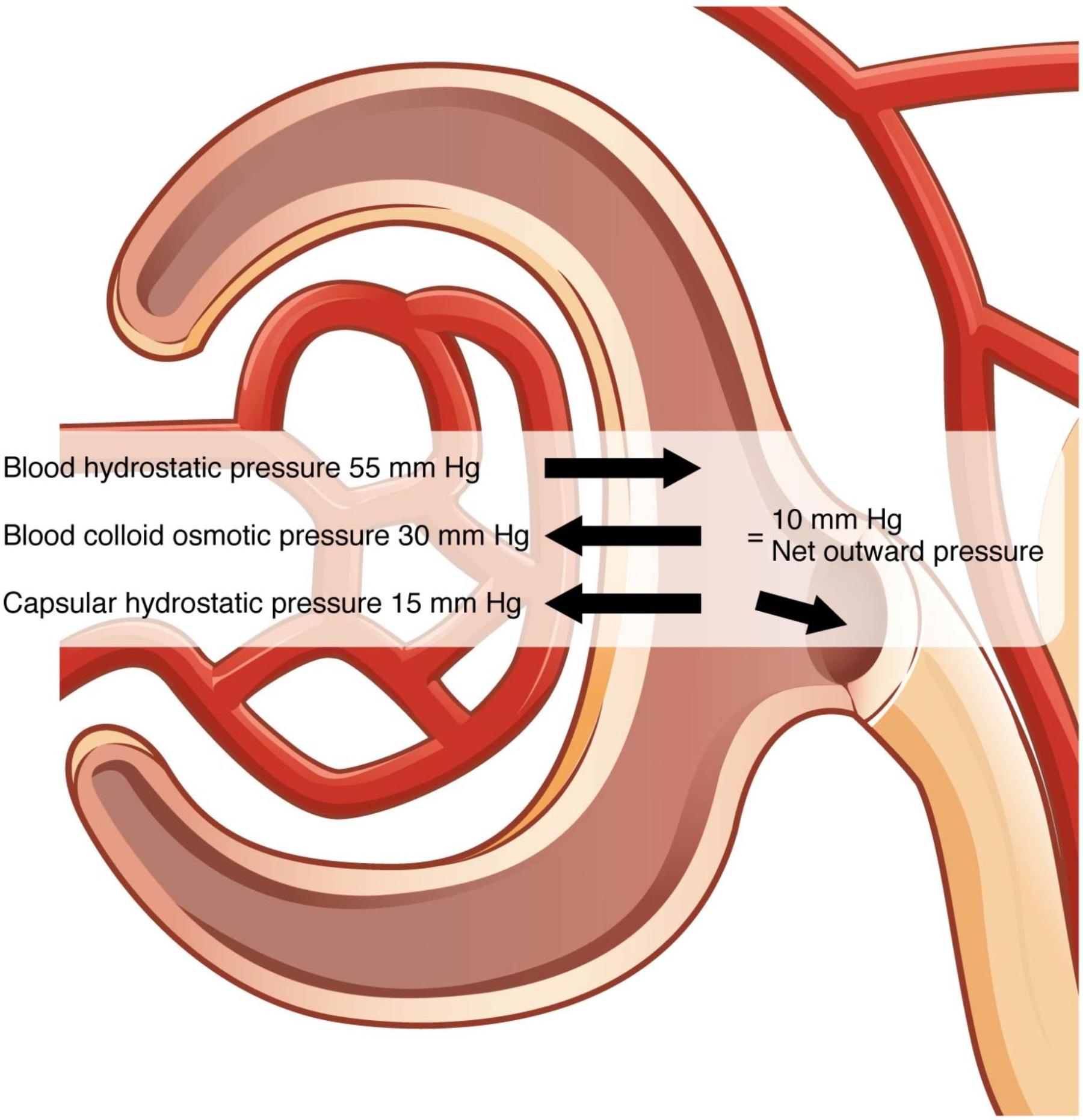The formation of urine begins with the precise process of glomerular filtration, driven by a delicate balance of opposing forces encapsulated within the Net Filtration Pressure (NFP). This article demystifies the Net Filtration Pressure, explaining the key hydrostatic and osmotic pressures that govern fluid movement from the blood into Bowman’s capsule. Understanding NFP is fundamental to comprehending kidney function, assessing renal health, and diagnosing conditions affecting the glomerular filtration rate.

Blood hydrostatic pressure 55 mm Hg: This is the pressure exerted by the blood within the glomerular capillaries, pushing fluid out of the capillaries and into Bowman’s capsule. It is the primary force favoring filtration, maintained relatively high due to the efferent arteriole’s smaller diameter.
Blood colloid osmotic pressure 30 mm Hg: This is the osmotic pressure exerted by proteins in the blood plasma, pulling water back into the glomerular capillaries. It opposes filtration, as water tends to move towards the higher concentration of solutes (proteins) in the blood.
Capsular hydrostatic pressure 15 mm Hg: This is the pressure exerted by the fluid already present in Bowman’s capsule, pushing fluid back into the glomerular capillaries. It also opposes filtration, creating a resistance to further fluid movement from the blood.
10 mm Hg Net outward pressure: This represents the overall driving force for glomerular filtration, calculated as the sum of all pressures favoring and opposing filtration. A positive net outward pressure indicates that filtration is occurring, pushing fluid from the glomerulus into Bowman’s capsule.
The kidneys tirelessly filter vast volumes of blood each day, removing waste products and maintaining fluid and electrolyte balance. This essential process initiates within the glomerulus, where blood plasma is filtered to form a preliminary filtrate. The efficiency and volume of this initial filtration are precisely governed by the Net Filtration Pressure (NFP). NFP represents the algebraic sum of all the forces that either encourage or oppose the movement of fluid across the glomerular capillary walls. This diagram clearly illustrates these crucial pressure components and their combined effect, highlighting why understanding them is central to renal physiology.
At the heart of glomerular filtration are three primary pressures: one favoring filtration and two opposing it. The main force driving fluid out of the glomerulus and into Bowman’s capsule is the blood hydrostatic pressure, typically around 55 mmHg. This pressure is significantly higher than in other capillaries due to the unique arrangement of the afferent and efferent arterioles, which ensures a robust outward push. Opposing this force are two pressures: the blood colloid osmotic pressure, approximately 30 mmHg, which pulls water back into the capillaries due to the presence of plasma proteins, and the capsular hydrostatic pressure, around 15 mmHg, exerted by the fluid already accumulated within Bowman’s capsule.
The Net Filtration Pressure (NFP) is calculated by subtracting the opposing forces from the favoring force:
NFP = Blood Hydrostatic Pressure – (Blood Colloid Osmotic Pressure + Capsular Hydrostatic Pressure)
NFP = 55 mmHg – (30 mmHg + 15 mmHg)
NFP = 55 mmHg – 45 mmHg
NFP = 10 mmHg
This 10 mm Hg net outward pressure is the physiological driving force that ensures a continuous flow of filtrate into the renal tubules. Even a small change in any of these pressures can significantly alter the glomerular filtration rate (GFR), which is a crucial indicator of kidney function. For instance, a decrease in systemic blood pressure can lower glomerular hydrostatic pressure, reducing NFP and thus GFR. Conversely, an increase in capsular hydrostatic pressure, perhaps due to a urinary tract obstruction, would also decrease NFP and GFR.
Disruptions to the delicate balance of Net Filtration Pressure are central to the pathophysiology of numerous kidney diseases. For example, severe dehydration or hemorrhage can lead to a significant drop in blood hydrostatic pressure, severely compromising GFR and potentially leading to acute kidney injury. Conditions like proteinuria, where large amounts of protein leak into Bowman’s capsule, would reduce the blood colloid osmotic pressure, paradoxically increasing NFP initially but leading to long-term renal damage. Moreover, urinary tract obstructions, such as kidney stones or an enlarged prostate, can elevate capsular hydrostatic pressure, directly impeding filtration. Understanding the components of NFP and their dynamic interplay is therefore essential for clinicians to diagnose and manage renal disorders effectively, monitor kidney health, and implement strategies to preserve renal function in patients.

